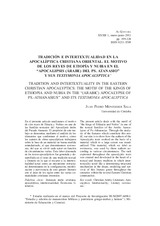Mostrar el registro sencillo del ítem
Tradición e intertextualidad en la apocalíptica cristiana oriental. El motivo de los reyes de Etiopía y Nubia en el "Apocalipsis (árabe) del ps. Atanasio" y sus Testimonia apocalyptica
| dc.contributor.author | Monferrer-Sala, J. P. | |
| dc.date.accessioned | 2012-10-26T10:08:52Z | |
| dc.date.available | 2012-10-26T10:08:52Z | |
| dc.date.issued | 2011 | |
| dc.identifier.uri | http://hdl.handle.net/10396/8115 | |
| dc.description.abstract | En el presente artículo analizamos el motivo de «los reyes de Etiopía y Nubia» en una de las familias textuales del Apocalipsis árabe del Pseudo Atanasio. El propósito de este trabajo es demostrar, mediante el análisis de los elementos que conforman el motivo, cómo los autores de obras apocalípticas trabajaron sobre la base de un material en buena medida estandarizado, al que denominamos ????????????????????????????- ????????????, del que se sirvió cada autor en función de circunstancias varias. Esta labor plasmada en los textos apocalípticos fue generada y desarrollada en el seno de una tradición textual y literaria en la que el recurso a la intertextualidad actuó como un mecanismo estructural determinante en la configuración, modelización y pervivencia de este género literario con el paso de los siglos entre las varias comunidades cristianas orientales | es_ES |
| dc.description.abstract | The present article deals with the motif of “the kings of Ethiopia and Nubia” in one of the textual families of the Arabic Apocalypse of Ps.-Athanasius. Through the analysis of the features which constitute this motif, our aim is to show how the authors of the Apocalyptic texts worked on the basis of a material which to a large extent was standardized. This material, which we label as ??????????????????????????????, was used by these authors according to various circumstances. The task expressed throughout the apocalyptic texts was created and developed in the heart of a textual and literary tradition in which intertextuality acted like a determining structural mechanism in the shape, modeling and survival of this literary genre throughout the centuries within the several Eastern Christian communities. | es_ES |
| dc.format.mimetype | application/pdf | es_ES |
| dc.language.iso | spa | es_ES |
| dc.publisher | Consejo Superior de Investigaciones Científicas (CSIC) | es_ES |
| dc.rights | https://creativecommons.org/licenses/by-nc-nd/4.0/ | es_ES |
| dc.source | Al-Qantara. Revista de Estudios Árabes XXXII (1), 199-228 (2011) | es_ES |
| dc.subject | Literatura árabe cristiana | es_ES |
| dc.subject | Apocalíptica | es_ES |
| dc.subject | Intertextualidad | es_ES |
| dc.subject | Testimonia literarios | es_ES |
| dc.title | Tradición e intertextualidad en la apocalíptica cristiana oriental. El motivo de los reyes de Etiopía y Nubia en el "Apocalipsis (árabe) del ps. Atanasio" y sus Testimonia apocalyptica | es_ES |
| dc.title.alternative | Tradition and intertextuality in the eastern christian apocalyptics: the motif of the kings of Ethiopia and Nubia in the "(arabic) Apocalypse of ps.- Athanasius" and its Testimonia apocalyptica | es_ES |
| dc.type | info:eu-repo/semantics/article | es_ES |
| dc.rights.accessRights | info:eu-repo/semantics/openAccess | es_ES |

